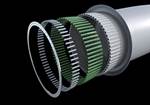Japan: Floating wind farm
Since the 2011 tsunami and related nuclear disaster in Fukushima, Japan, that country’s political leaders have provided incentives for development of floating offshore wind farms in the deep water offshore of Japan's coastline.
Since the 2011 tsunami and related nuclear disaster in Fukushima, Japan, that country’s political leaders have been reassessing the country's energy policy. One result has been the introduction, this past year, of a more attractive financial incentive for offshore wind farm development. In response, a host of Japanese firms announced plans to develop conventional, fixed-foundation offshore wind farms.
A recently announced project, known as Forward (Fukushima floating offshore wind farm demonstration), will be delivered by a consortium of 11 companies and join two floating scale pilots already in Japanese waters. Funded entirely by the Japanese Ministry of Economy, Trade and Industry, the project will have a leadership team provided by conglomerate Marubeni (Tokyo, Japan), with the University of Tokyo acting as technical advisor.
Another effort is a 300-MW project led by Hitachi Zosen Corp. (Osaka, Japan). This is problematic, however, because Japan's long coastline boasts relatively few locations where the water is shallow for some distance from shore, maming them suitable for large fixed-foundation projects. Instead, water depths plunge quickly near the shoreline. The conditions are similar off the coasts of Portugal and the U.S. state of Maine, and research proceeds in both locations to develop cost-effective floating technology. Japan is following suit.
Forward will initially consist of three floating wind turbines and one floating power substation off the coast of Fukushima. The first stage, already underway, consists of one 2-MW floating wind turbine, the world’s first 66-kV floating power substation and an undersea cabling system. In the second stage, two 7-MW wind turbines will be installed between 2013 and 2015. Industrial development partners will include Mitsubishi Heavy Industries; shipbuilder Japan Marine United Corp. (formerly IHI Marine); Hitachi Zosen, which purchased Fuji Subaru’s wind turbine business; and Mitsui Engineering. All are based in Tokyo, Japan. Reportedly, Mitsui will be responsible for the foundations, wind turbines and blades for the initial phases.
The floating foundations, it is rumored, will be of the semisubmersible type. The project will ultimately include 143 floating wind turbines stationed 10 miles off the coast and could generate up to 1 GW of power as part of a national plan to increase renewable energy resources.
Project manager Takeshi Ishihara of the University of Tokyo has said in published reports that "this project is important — I think it is impossible to use nuclear power in Fukushima again." For their part, political leaders within Fukushima prefecture have made it known that they intend for it to be completely energy self-sufficient by 2040.
Related Content
-
Drag-based wind turbine design for higher energy capture
Claiming significantly higher power generation capacity than traditional blades, Xenecore aims to scale up its current monocoque, fan-shaped wind blades, made via compression molded carbon fiber/epoxy with I-beam ribs and microsphere structural foam.
-
JEC World 2022, Part 3: Emphasizing emerging markets, thermoplastics and carbon fiber
CW editor-in-chief Jeff Sloan identifies companies exhibiting at JEC World 2022 that are advancing both materials and technologies for the growing AAM, hydrogen, automotive and sustainability markets.
-
Infinite Composites: Type V tanks for space, hydrogen, automotive and more
After a decade of proving its linerless, weight-saving composite tanks with NASA and more than 30 aerospace companies, this CryoSphere pioneer is scaling for growth in commercial space and sustainable transportation on Earth.
















